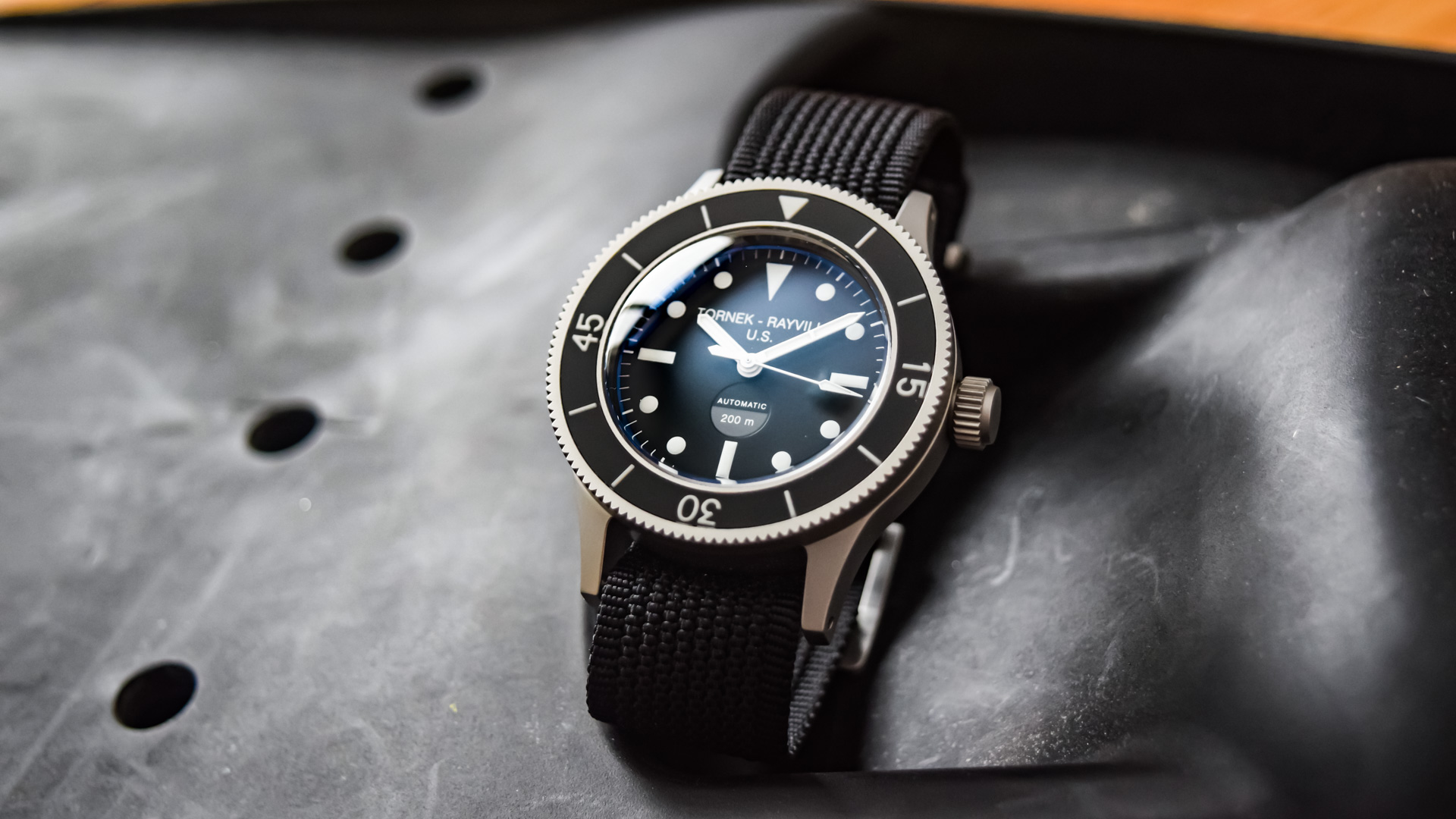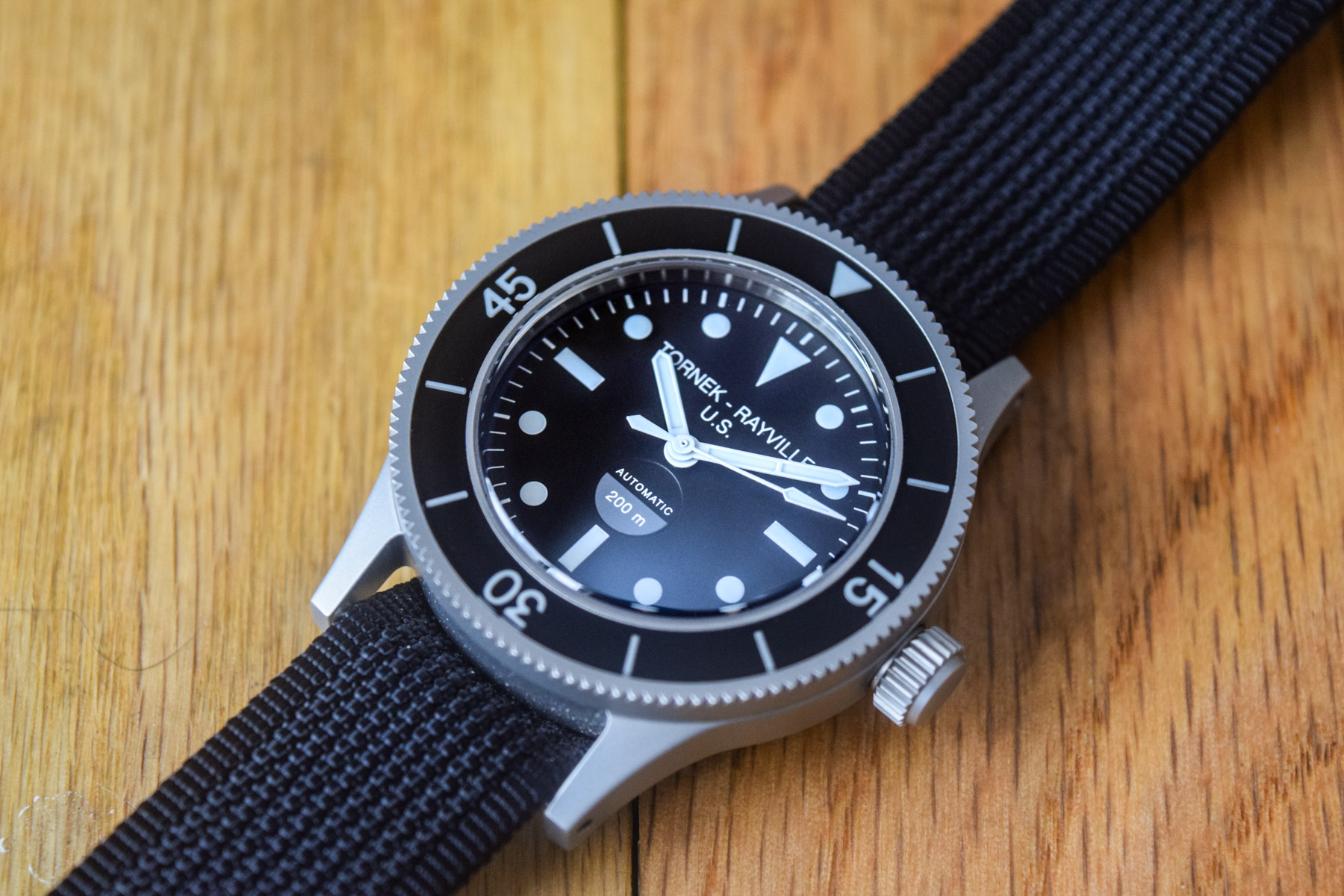 Over the course of the last 10 or so years since microbrands began to crowd the enthusiast market, the established model has remained much the same: Take an iconic watch rendered unobtainable due to scarcity or cost, from somewhere within watchmaking’s history, and produce a less expensive alternative that captures the essence of its inspiration while also providing modern specifications and, most importantly, attainability. Mk II, brainchild of Bill Yao, has largely followed that model since way back in 2002 — modernizing, stylizing, and technically enhancing some of history’s most storied dive and military references. What is less common, however, is the idea of a microbrand endeavoring to actually become the thing they set out to imitate. Bill Yao’s latest venture, Tornek-Rayville, has done exactly that, releasing a new model in the TR-660, a watch that shares the bulk of its visual design DNA as well as full legal rights to the Tornek-Rayville name with its historic combat diving forebear, the TR-900, one of the rarest, most collectible, and least understood military watches in existence.
Over the course of the last 10 or so years since microbrands began to crowd the enthusiast market, the established model has remained much the same: Take an iconic watch rendered unobtainable due to scarcity or cost, from somewhere within watchmaking’s history, and produce a less expensive alternative that captures the essence of its inspiration while also providing modern specifications and, most importantly, attainability. Mk II, brainchild of Bill Yao, has largely followed that model since way back in 2002 — modernizing, stylizing, and technically enhancing some of history’s most storied dive and military references. What is less common, however, is the idea of a microbrand endeavoring to actually become the thing they set out to imitate. Bill Yao’s latest venture, Tornek-Rayville, has done exactly that, releasing a new model in the TR-660, a watch that shares the bulk of its visual design DNA as well as full legal rights to the Tornek-Rayville name with its historic combat diving forebear, the TR-900, one of the rarest, most collectible, and least understood military watches in existence.
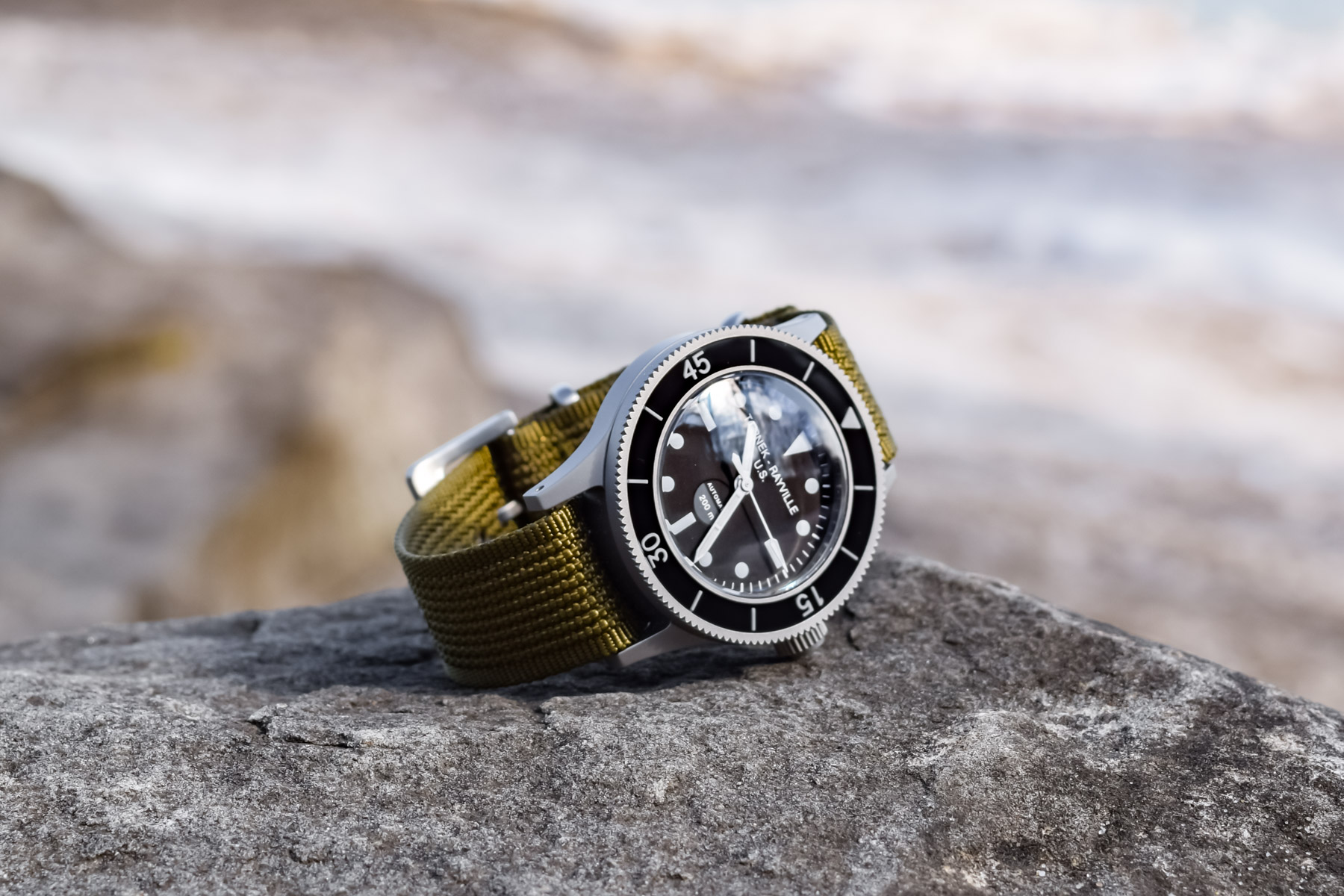 (Murky) Historical Context
(Murky) Historical Context
Before we slip on our proverbial wetsuit, fins, and aggressive-looking mask and dive into the new TR-660, it’s important to contextualize the modern Tornek-Rayville for what it is: a new chapter in an intriguing brand history dating back to the late 1950s and the unique conception story behind the TR-900. In short, as the U.S. military was developing enhanced waterborne special operations capabilities spurred by the impressive successes of US Navy Underwater Demolition Teams (UDT) in WWII, a need arose for a wristwatch built to withstand the unique tactical amphibious use-case of these developing commando units. As it does, the government outlined its needs with impressive detail in MIL-W-22176A, a military specification detailing everything a “WATCH, WRIST, SUBMERSIBLE, (400 FOOT), NON-MAGNETIC” could ever need to do or be.
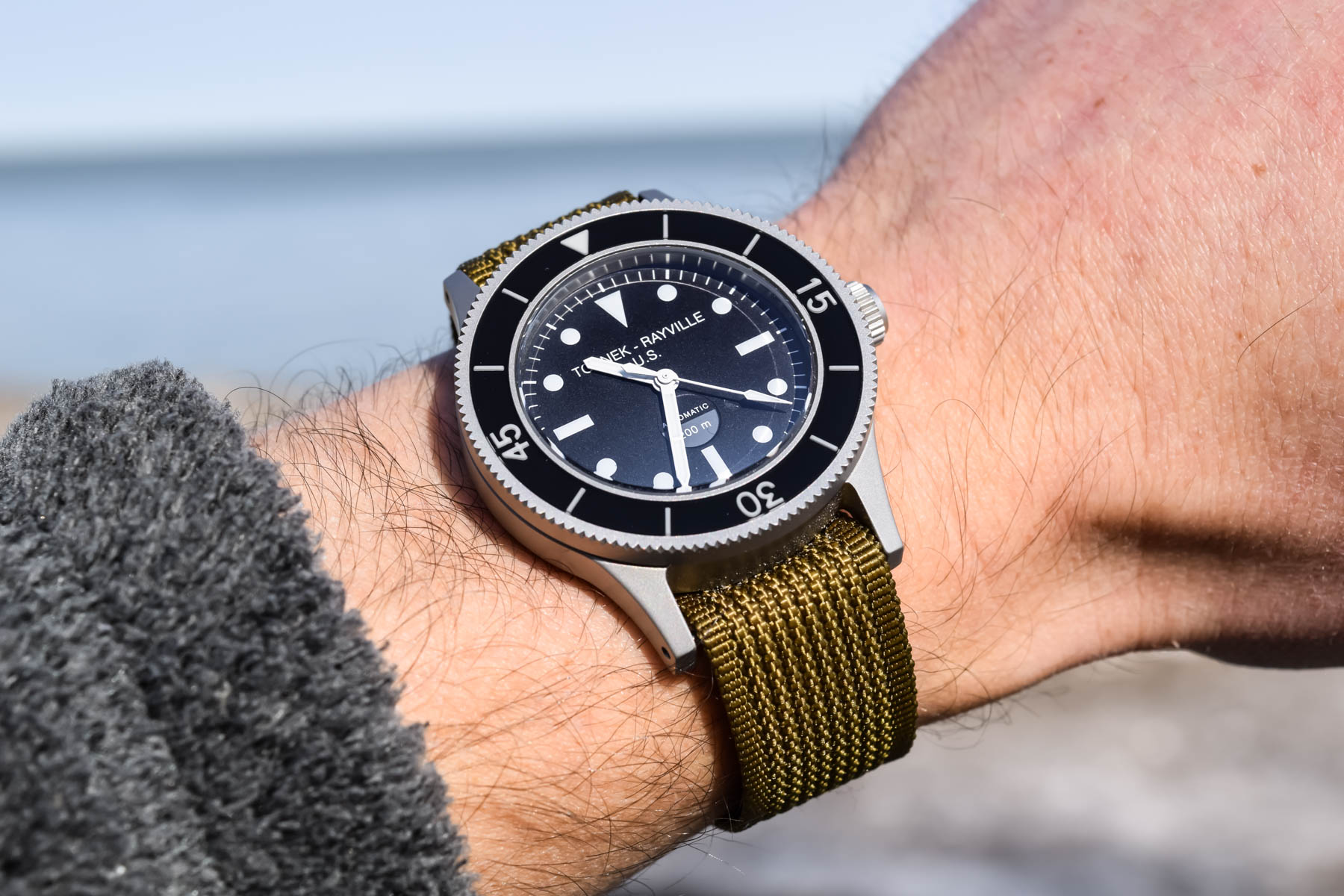 At this stage, some of you are likely wondering why the U.S. government didn’t simply place an order for the Rolex Submariner, Zodiac Sea Wolf, or Blancpain Fifty Fathoms, some of the most prominent names on the civilian underwater watch market of the day. Here, we have to take into account the United States’ official guidelines as outlined in the Buy American Act of 1933, which required the purchase of military equipment from United States domestic sources whenever possible. The military had extensively tested commercially available dive watches including the Rolex Submariner, Blancpain Fifty Fathoms, and even the now-rare Enicar Sea Pearl, with the Fifty Fathoms, in particular, performing well, but still wanted the opportunity to purchase American. That constraint in mind, MIL-W-22176A was shared with leading U.S. watch brands like Hamilton, Elgin, and Bulova, all of whom had already supplied a number of watches to the U.S. military.
At this stage, some of you are likely wondering why the U.S. government didn’t simply place an order for the Rolex Submariner, Zodiac Sea Wolf, or Blancpain Fifty Fathoms, some of the most prominent names on the civilian underwater watch market of the day. Here, we have to take into account the United States’ official guidelines as outlined in the Buy American Act of 1933, which required the purchase of military equipment from United States domestic sources whenever possible. The military had extensively tested commercially available dive watches including the Rolex Submariner, Blancpain Fifty Fathoms, and even the now-rare Enicar Sea Pearl, with the Fifty Fathoms, in particular, performing well, but still wanted the opportunity to purchase American. That constraint in mind, MIL-W-22176A was shared with leading U.S. watch brands like Hamilton, Elgin, and Bulova, all of whom had already supplied a number of watches to the U.S. military.
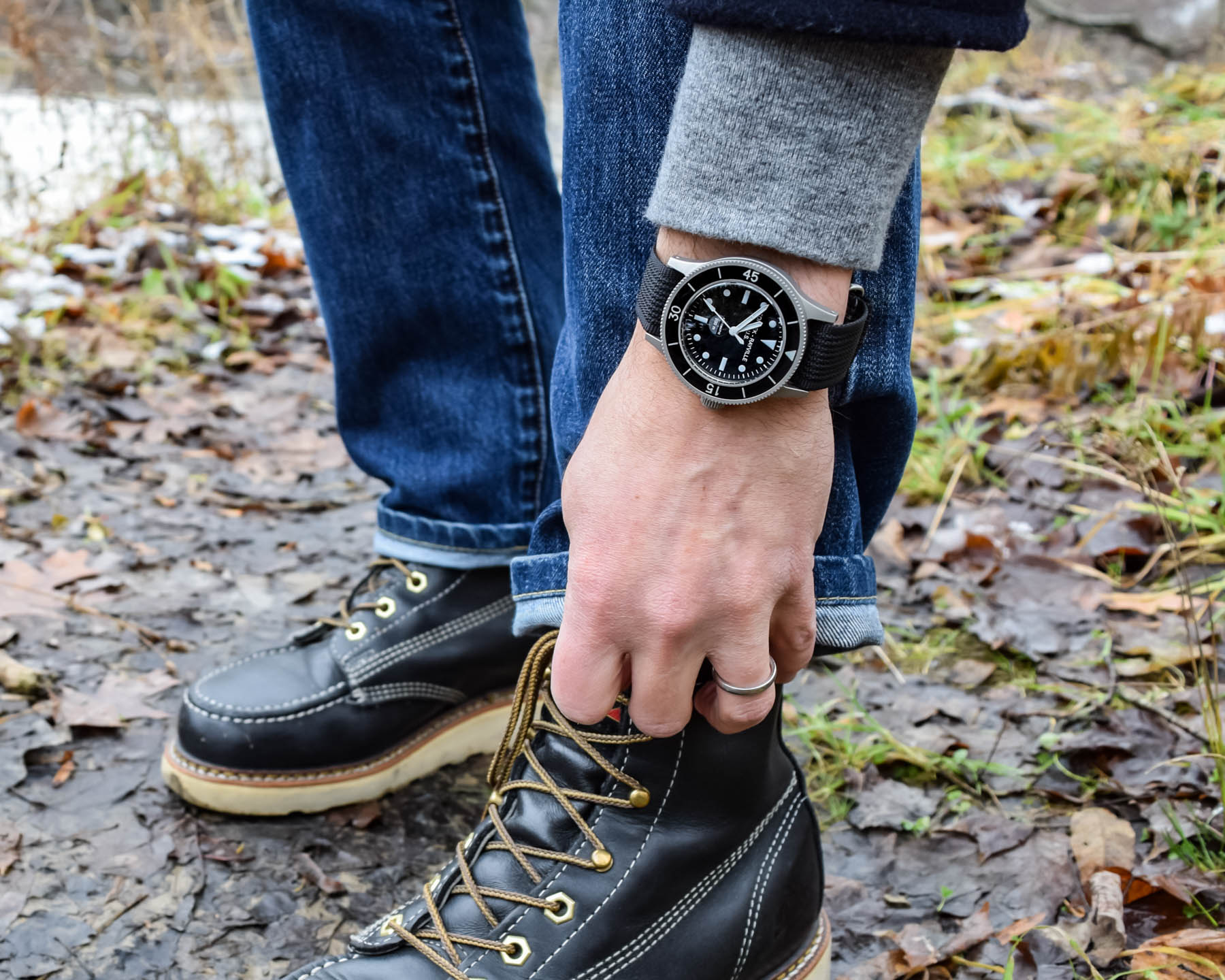 With former U.S. Army General Omar Bradley as chair, Bulova seemed the obvious choice for producing the new commando dive watch, developing and providing a series of prototypes that was ultimately not selected, having surprisingly failed testing by the U.S. Navy Experimental Diving Unit (NEDU) on multiple well-documented occasions. These are elements that, at least for me, make the recent Bulova MIL-SHIPS reissue, which also has a nonsensical Mk V diving helmet (these were watches intended for combat swimmers, i.e. scuba divers, and not hard hat wearing deep sea divers) on its caseback, all the more confusing, but I digress.
With former U.S. Army General Omar Bradley as chair, Bulova seemed the obvious choice for producing the new commando dive watch, developing and providing a series of prototypes that was ultimately not selected, having surprisingly failed testing by the U.S. Navy Experimental Diving Unit (NEDU) on multiple well-documented occasions. These are elements that, at least for me, make the recent Bulova MIL-SHIPS reissue, which also has a nonsensical Mk V diving helmet (these were watches intended for combat swimmers, i.e. scuba divers, and not hard hat wearing deep sea divers) on its caseback, all the more confusing, but I digress.
The eventual winner of the contract meant to satisfy MIL-W-22176A came from an unlikely source in Allen Tornek, U.S. distributor and importer of Blancpain, and also the kind of crafty businessperson who recognized an opportunity when he saw it. Tornek elected to simply rebadge a (very gently) modified Blancpain Fifty Fathoms, a watch already known to possess impressive undersea acumen from testing of commercially available dive watches already undertaken by the NEDU, in an effort to ever so casually subvert the Buy American Act. Tornek’s guile was rewarded, the prototype Tornek-Rayville excelled in testing, and initial orders were placed. The first batch of TR-900s was delivered to US fighting forces, including the US Navy SEALs, USMC Force Recon, and the shadowy operators of MACV-SOG, in 1963, only two short years after the first U.S. Special Operations Forces entered Vietnam.
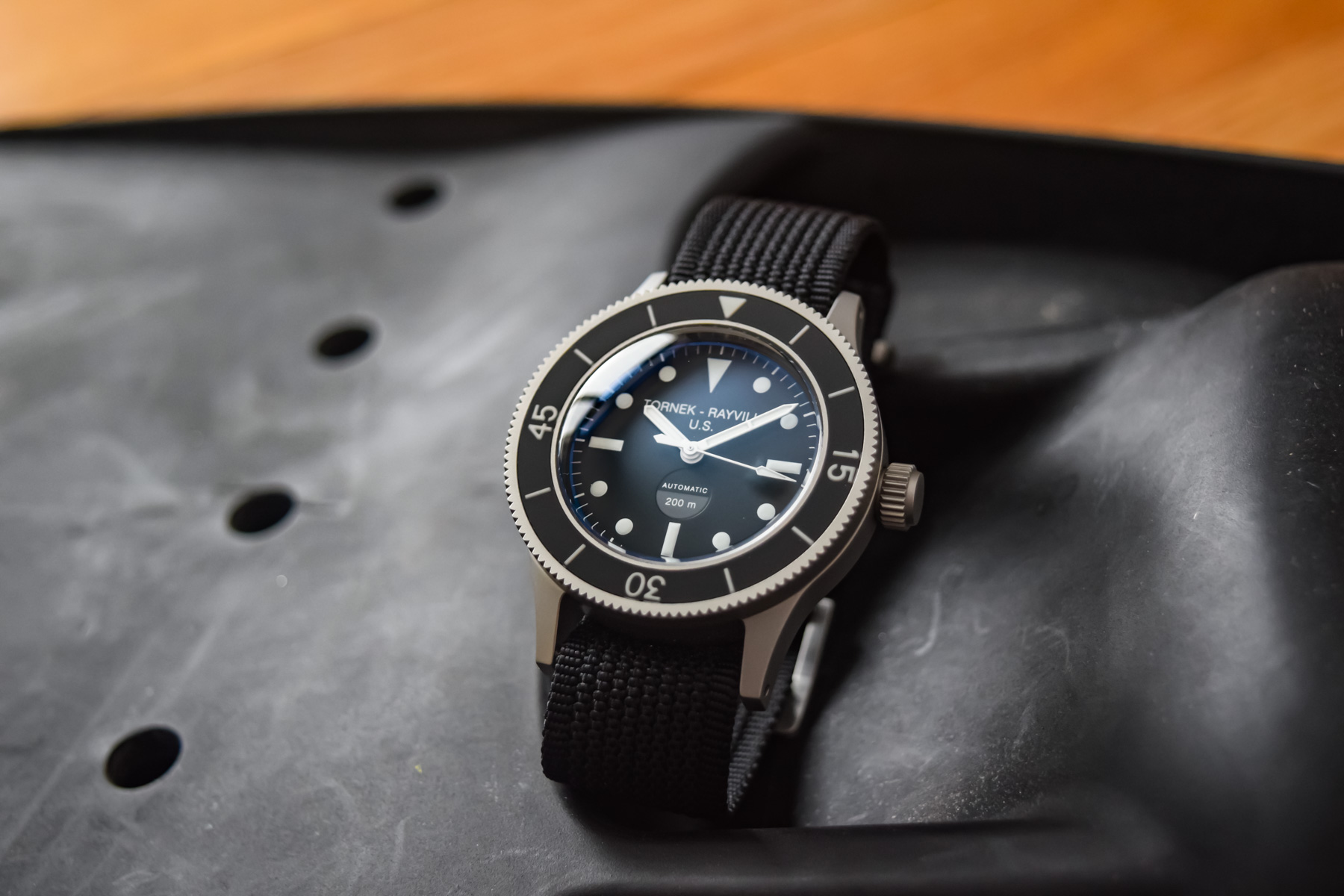 Despite the proven ruggedness of the TR-900 and its operational success in the theater of combat, the watch was delivered with what were ultimately a few fatal flaws that, along with the austere conditions under which the original watches were utilized, meant that almost none of the original 1000 (or potentially more) TR-900s are in existence today. The original watches utilized promethium luminescent material on their dials and hands as opposed to the then more commercially common tritium paint. Mildly radioactive promethium glows significantly brighter and for longer in many instances, but also has a short half life of only around two and a half years. When the watches lost their glow and, therefore, much of their operational effectiveness, they were returned to stores where they were in most cases unceremoniously discarded as potentially dangerous radioactive material. Some years after the initial delivery, Allen Tornek again approached the U.S. Navy looking for another order, but the growing intensity and cost of the war in Vietnam meant there were no surplus funds for specialized commando watches, and the TR-900 was all but lost to time, other than the few examples preserved in most cases by the enlisted to whom they were originally issued.
Despite the proven ruggedness of the TR-900 and its operational success in the theater of combat, the watch was delivered with what were ultimately a few fatal flaws that, along with the austere conditions under which the original watches were utilized, meant that almost none of the original 1000 (or potentially more) TR-900s are in existence today. The original watches utilized promethium luminescent material on their dials and hands as opposed to the then more commercially common tritium paint. Mildly radioactive promethium glows significantly brighter and for longer in many instances, but also has a short half life of only around two and a half years. When the watches lost their glow and, therefore, much of their operational effectiveness, they were returned to stores where they were in most cases unceremoniously discarded as potentially dangerous radioactive material. Some years after the initial delivery, Allen Tornek again approached the U.S. Navy looking for another order, but the growing intensity and cost of the war in Vietnam meant there were no surplus funds for specialized commando watches, and the TR-900 was all but lost to time, other than the few examples preserved in most cases by the enlisted to whom they were originally issued.
And for decades, that was essentially the story of Tornek-Rayville, an obscure military footnote in the legendary history of the Blancpain Fifty Fathoms. In the years leading up to today’s unbelievable watch-collecting landscape, frankly, few in the mass watch market cared about a modified Blancpain dive watch produced in fewer than 1000 examples and largely obsolete, a clandestine legacy unfortunately shared by the secretive heroes that wore the TR-900 in combat. In order to resurrect a brand like Tornek-Rayville, a few essential characteristics were needed. First, an obsession with military history, especially as it relates to watches, with an emphasis on the unsung heroes of Vietnam’s special operations communities. And second, a painstaking attention to detail in order to avoid the pitfalls of so many cutesy “retro-inspired” microbrand offerings.
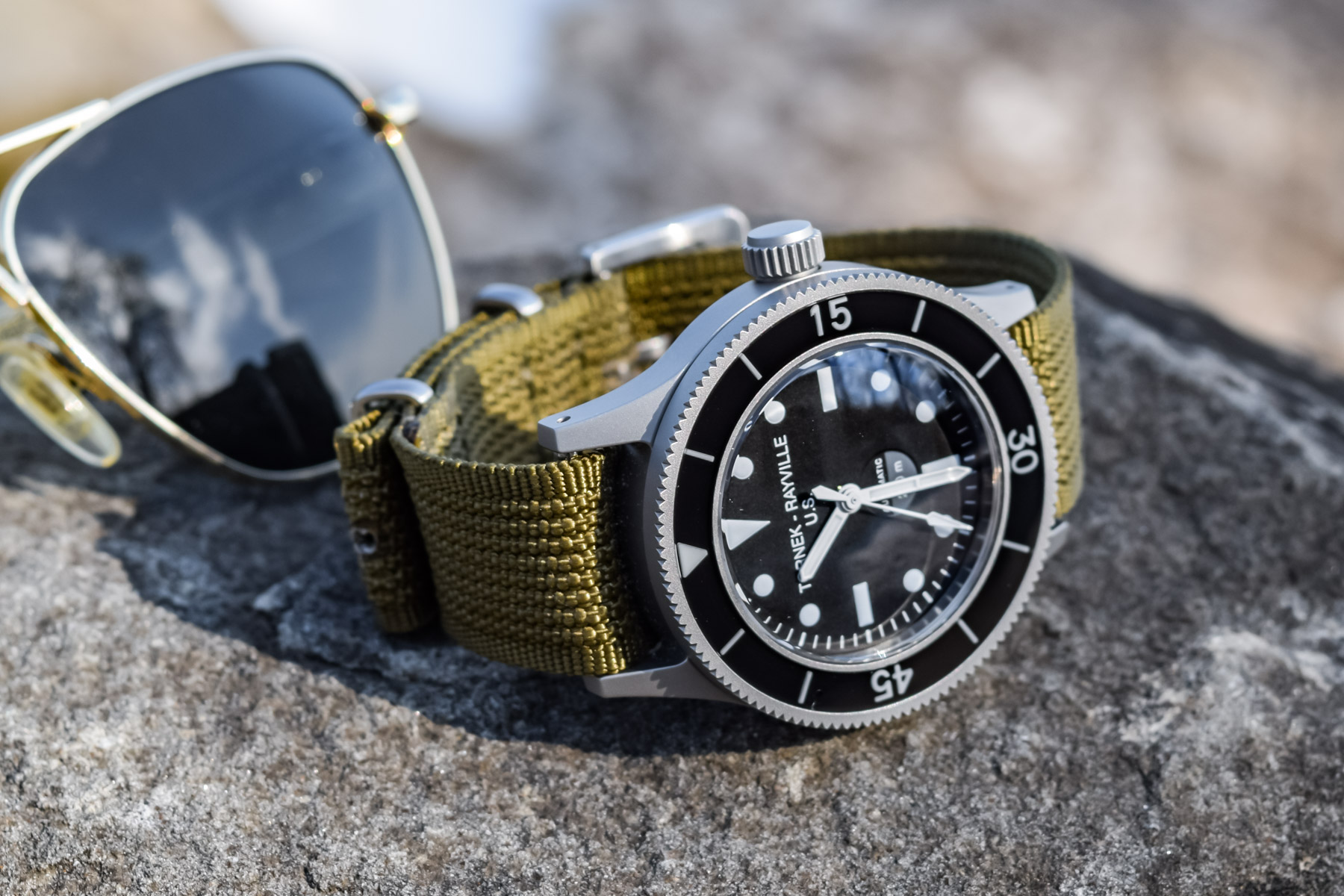 Enter Bill Yao. Mk II is a well established enterprise, well regarded among the enthusiast community for Yao’s design acumen, as well as his incredible attention to detail from a watchmaking point of view. And while it can admittedly take a while to get an Mk II, most by now understand that the wait will ultimately be worth it. And when Yao had the opportunity to purchase the Tornek-Rayville name and trademark years ago for a (probably surprisingly small) sum he elected not to share with me, he jumped at the opportunity, placing the rights in his back pocket until he could give not only the watch, but also the brand itself, the attention he felt it deserved.
Enter Bill Yao. Mk II is a well established enterprise, well regarded among the enthusiast community for Yao’s design acumen, as well as his incredible attention to detail from a watchmaking point of view. And while it can admittedly take a while to get an Mk II, most by now understand that the wait will ultimately be worth it. And when Yao had the opportunity to purchase the Tornek-Rayville name and trademark years ago for a (probably surprisingly small) sum he elected not to share with me, he jumped at the opportunity, placing the rights in his back pocket until he could give not only the watch, but also the brand itself, the attention he felt it deserved.
At right around this point, if not sooner, you’ll notice I’ve spent a fair portion of this text recounting the history of Tornek-Rayville, and while that would typically not make sense when describing a modern watch based on a historic model, it’s important to note that the history of the original watch is inextricably tied to the modern TR-660. More than an homage, the brand itself has returned, and so the history is shared. Of course, there was a gap of a fair few decades, but if Doxa, Synchron, Aquadive, Aquastar, and so many other “resurrected” brands can claim their, at times, almost completely unrelated historical laurels, then I believe Yao has earned the right with Tornek-Rayville, as well. Stepping down from the well-worn Pelican case I’ve thus far used as a soapbox, let us now don our vintage military diving gear and take a look at the modern TR-660.
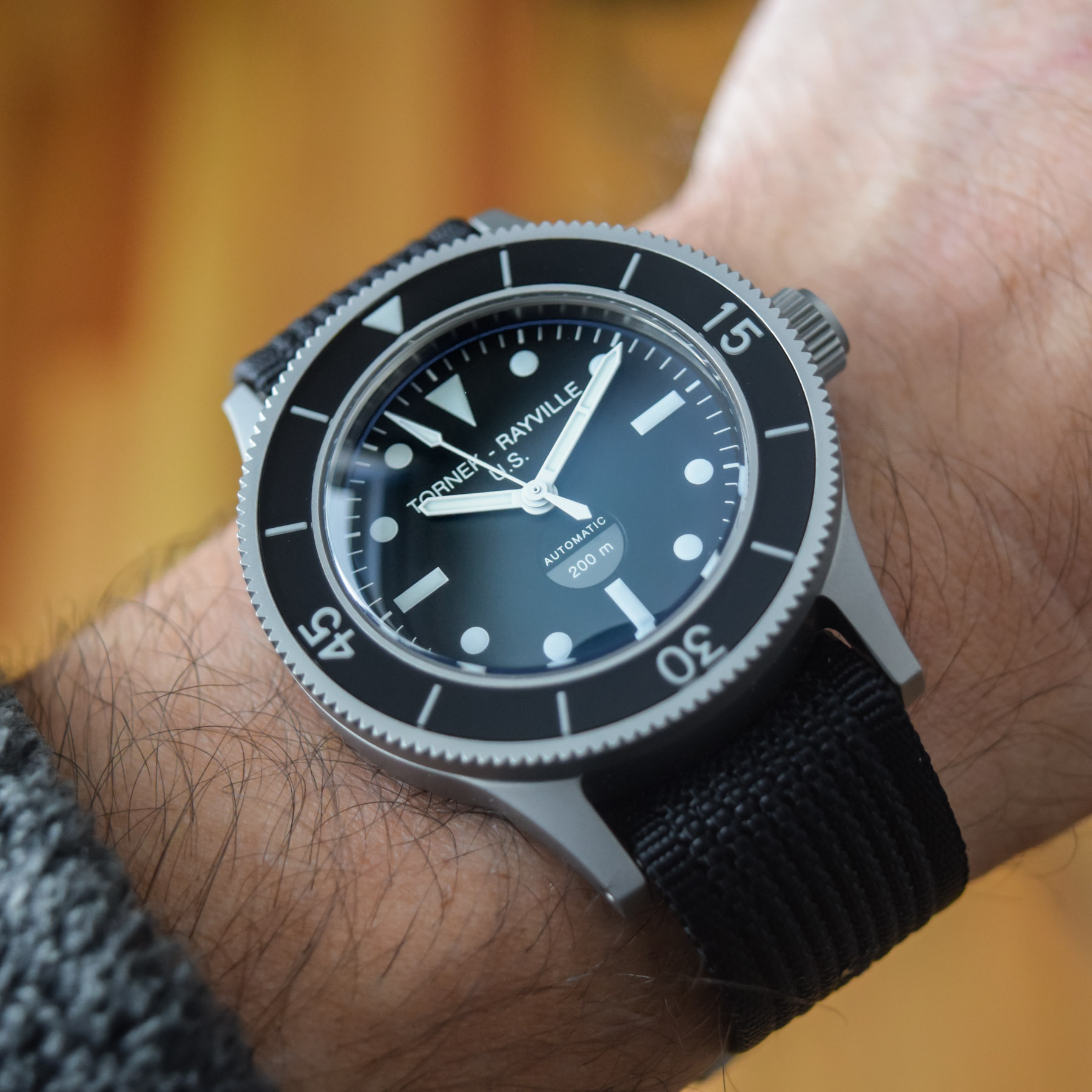 A Bead-Blasted, Well-Proportioned Case
A Bead-Blasted, Well-Proportioned Case
With the original TR-900, the biggest differences came in the form of the dial, specially procured by Allen Tornek himself, but also in the case. Where the civilian-oriented Fifty Fathoms leaned into brushing and polishing befitting its non-tactical-usecase, military specifications called for less reflective finish. The modern TR-660 leans into fine bead blasting across its straight-forward architecture, which is itself a painstakingly modified take on the original case concept. At 40mm in width and 48.5mm in length, with an overall thickness of 14.7mm thanks to a domed sapphire crystal, the new watch is smaller in diameter, slightly shorter in length, and around the same thickness as its predecessor, offering a modernized and more versatile wearing experience compared to the original design. The TR-900 featured what would today be considered an annoying 19mm lug width, with the TR-660 offering a standard 20mm metric that opens the watch up to virtually all strap possibilities while also offering the security of ISO-compliant reinforced spring bars as standard.
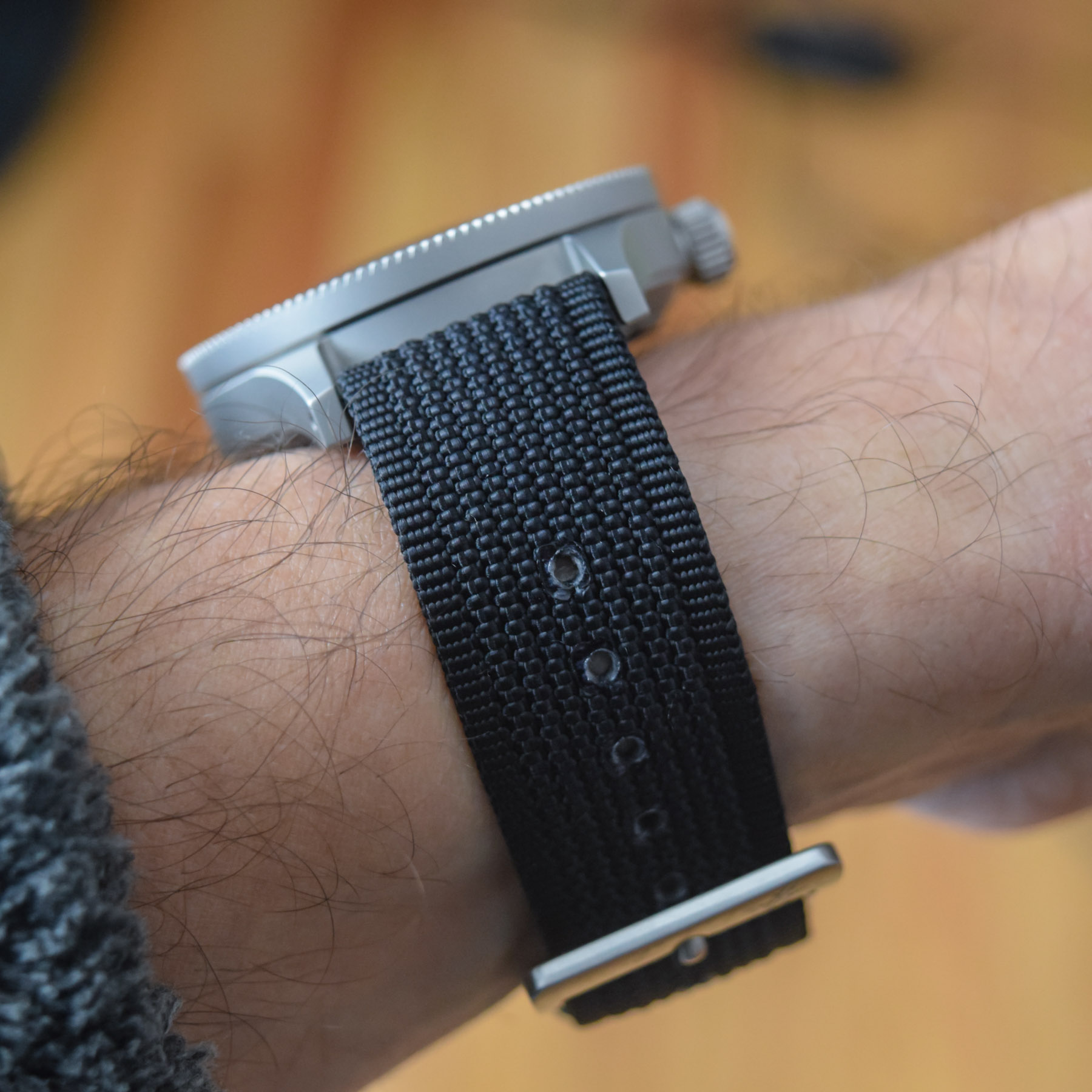 And far from simply throwing a 20mm nato on the TR-660 and calling it a day, Yao opted for a custom woven, single-pass nylon strap he calls the Nytex™ Type I-M2, meant to evoke the original issued strap and indeed much of the webbing of the day, with a custom signed buckle sporting a new stylized logo Yao designed with his wife. The logo combines the “Mu” symbol, which denoted the original watch’s anti-magnetic properties, and a stylized pair of harpoons meant to conjure a combat diving pair of operators. It’s a small thing, accounting for only a few square millimeters of the buckle, but for Bill Yao, no detail escapes, and it’s nice to see the level of attention to detail here.
And far from simply throwing a 20mm nato on the TR-660 and calling it a day, Yao opted for a custom woven, single-pass nylon strap he calls the Nytex™ Type I-M2, meant to evoke the original issued strap and indeed much of the webbing of the day, with a custom signed buckle sporting a new stylized logo Yao designed with his wife. The logo combines the “Mu” symbol, which denoted the original watch’s anti-magnetic properties, and a stylized pair of harpoons meant to conjure a combat diving pair of operators. It’s a small thing, accounting for only a few square millimeters of the buckle, but for Bill Yao, no detail escapes, and it’s nice to see the level of attention to detail here.
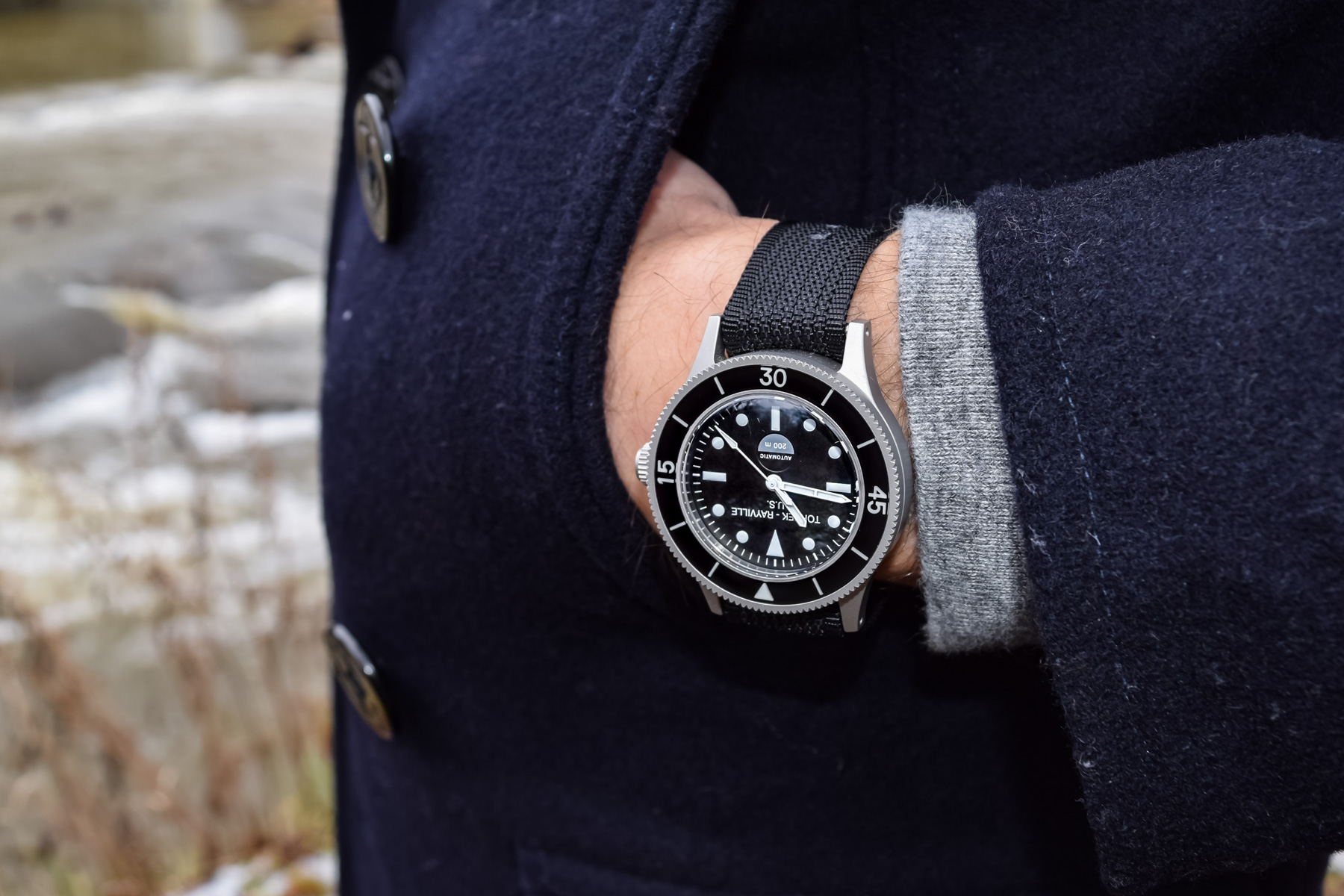 Where the watch meets the wrist, the TR-660 is equipped with a domed caseback often seen from Mk II watches such as the Paradive that makes for an improved wearing experience and helps the watch to sit right where you’d like it to without slipping, even when strung on a pull-through nylon strap. The bezel, which features vertical sides and fine but easily-grasped teeth at its perimeter, rotates unidirectionally with 120 positive-feeling clicks while featuring the smallest amount of back play. A well-executed acrylic insert is enhanced with lumed indices that add a heavy dose of vintage vibes but, if durability is your number one concern, the watch can also be had with an anodized aluminum insert.
Where the watch meets the wrist, the TR-660 is equipped with a domed caseback often seen from Mk II watches such as the Paradive that makes for an improved wearing experience and helps the watch to sit right where you’d like it to without slipping, even when strung on a pull-through nylon strap. The bezel, which features vertical sides and fine but easily-grasped teeth at its perimeter, rotates unidirectionally with 120 positive-feeling clicks while featuring the smallest amount of back play. A well-executed acrylic insert is enhanced with lumed indices that add a heavy dose of vintage vibes but, if durability is your number one concern, the watch can also be had with an anodized aluminum insert.
This being a Bill Yao jam, there are no alignment or other QC issues to speak of, and the bezel’s zero index lines up with the dial with laser-like, heart-warming perfection. At 3 o
clock, a screw-down crown offers another point of differentiation compared to the vintage push/pull model, with a larger profile and more prominent ridges for an easy grip. While located without the safety of crown guards, the crown features a reinforced internal sleeve and double-gasket system that Yao asserts offers an impressive level of durability. Between the simply adorned screw-down caseback and screw-down crown, the modern TR-660 is rated to 200 meters, substantially deeper than the ten meter limit for any pure oxygen breathing combat diver and indeed deeper than anyone reading this text likely needs. If anyone reading this has been deeper, please let me know in the comments as I would like to ask you about your watches…
 Subtly Updated Dial
Subtly Updated Dial
Set beneath a slightly domed sapphire crystal, coated for anti-reflectivity on its underside, the TR-660 dial captures the design format of the original while being tastefully updated for modern needs. The major elements of the TR-900 are once again here, with circular, rectangular, and triangular indices and simple pencil hands set over a matte black primary surface. Like the original watch, “Tornek-Rayville, U.S.” is printed in extremely large text at noon, with Yao’s modern take on the original moisture indicator at six. The original MIL-W-22176A guidelines called for a moisture indicator placed on the dial that would change color in the event of of a watch’s failure in the arena of water resistance, providing a visual vue for the operator of the watch to know the timepiece could not be trusted to time a dive.
However, producing a watertight watch is markedly easier these days than it was at the time, and Yao elected to leave the moisture indicator behind with the new TR-660 while still keeping its essence in place with a simple black and gray circle that act as home for the “automatic” and “200m” text. If you think you need a moisture indicator and obsessively worry about flooding your watch, the new Bulova MIL-SHIPS does offer this functionality. Viewed together, the elements of this TR-660 dial follow its historic forebear in adding up to what is for me one of the most legible dive watch designs in existence, leaving behind the superfluous in favor of the simplest effective design. This impressive legibility and contrast extends into the night with a heaping helping of Arclite Super-LumiNova that glows green, glowing brightly while also matching in intensity between the dial, hands, and bezel. If lume is your thing, and I know it is for many of you, this watch doesn’t disappoint.
 A Solid Japanese Caliber
A Solid Japanese Caliber
As an important distinction, this watch stems from the lineage of Mk II’s Ready to Wear collection, which is made in Japan and equipped with Japanese calibers coming from Seiko’s third-party movement provider in SII or Seiko Instruments Inc. The TR-660 relies upon the NE15, essentially the off-the-shelf version of the 6R15 well known to Seiko nerds for its inclusion in a number of members of the Prospex diving collection. With a 21,600 VPH or 3 Hz beat rate, around 50 hours of power reserve, and a out of the box accuracy quoted at -15/+25 seconds per day, the NE15 offers a solid if not remarkable caliber for a watch like this one, and it’s important to note Yao regulates these watches in three positions, with this particular example keeping time at an impressive +2 seconds per day in a variety of positions. It’s not sexy, but a simple, straightforward caliber like this falls right in line with the utilitarian design concept of the original watch and therefore also this new version.
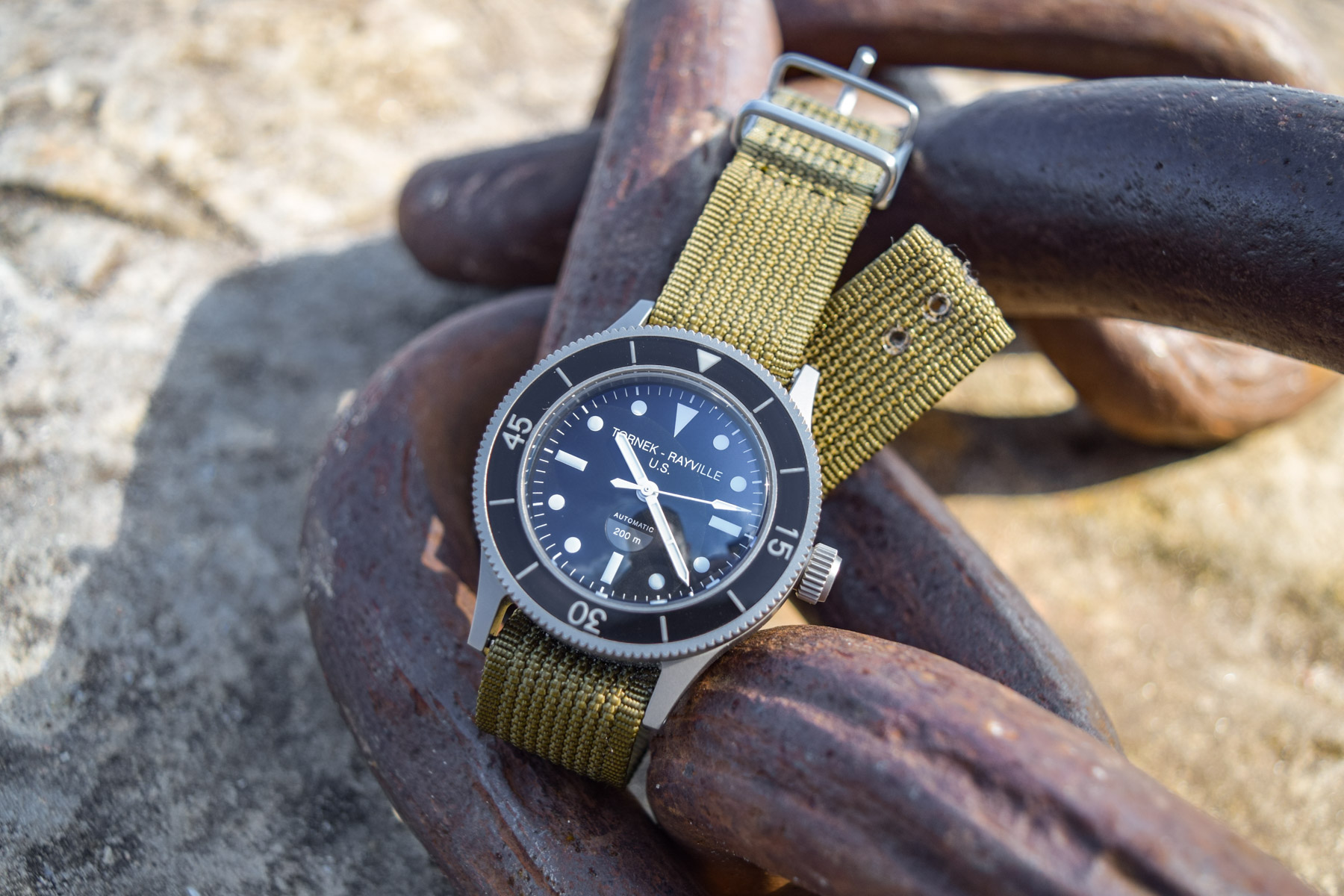 A Worthy Successor to an Obscure Icon?
A Worthy Successor to an Obscure Icon?
With that long-winded historical account and model overview now securely in hand, the question then becomes: How do I (or how should you) feel about this new Tornek-Rayville TR-660? Viewing the watch only as a watch, this is an impeccably built, attractive, and effective dive watch design from a trusted source in Mk II. It’s well-finished down the tiniest elements, and presents a pleasing wearing experience, especially for those interested in a subdued tactical appearance. The time keeping, lume, and legibility are excellent. While I haven’t been able to dive with this watch yet (Winter in the Midwest is one hell of a drug), I would expect flawless performance in that regard, as well.
We could argue about the subjectivity of value all day long as it relates to this TR-660’s $950 price point, but a watch is ultimately worth exactly what you are willing to pay for it, and considering that the first two rounds of pre-orders for this piece sold out in minutes, I’d say the price has been proven to be fair enough. But to view this watch only as the sum of its parts would be an oversight. As anyone within the watch space will tell you, a watch can be more than a watch, representing the history and heritage of its intended use-case as well as the resonance of the experiences of the original wearers. And while the original Tornek-Rayville TR-900 and the shadowy clandestine operators who changed history wearing it are all but relegated to obscurity, the successes of the TR-660 and the relaunched Tornek-Rayville brand ensure this design and its important heritage will continue to be felt in the modern era. The Tornek-Rayville TR-660 will be available for preorder with a 50% deposit of $475.50 in late summer of 2022 from tornek-rayville.us. In the meantime, go read Sergeant Major, U. S. Marines: The Biography of Sergeant Major Maurice J. Jacques, USMC to get a better understanding of the kinds of legends who wore the original Tornek-Rayville TR-900. To learn more visit tornek-rayville.us.
>Brand: Tornek-Rayville
>Model: TR-660
>Price: $950
>Size: Diameter: 40mm, Lug-to-Lug: 48.5mm, Thickness: 14.7mm, Lug Width: 20mm.
>When the reviewer would personally wear it: A great piece for casual environments or anything even remotely aquatic or tactical. When the Midwest thaws a bit, I’ll be taking this one diving ASAP.
>Friend we’d recommend it to first: The military history buff who also happens to be a watch nerd. There are a lot of these guys.
>Best characteristic of this watch: The faithful visual recreation of the iconic original design formula.
>Worst characteristic of this watch: In this price range, a lot of people are going to say this movement should be Swiss. I personally think the SII caliber makes sense here, but I have no trouble imagining the comments this piece will receive.

